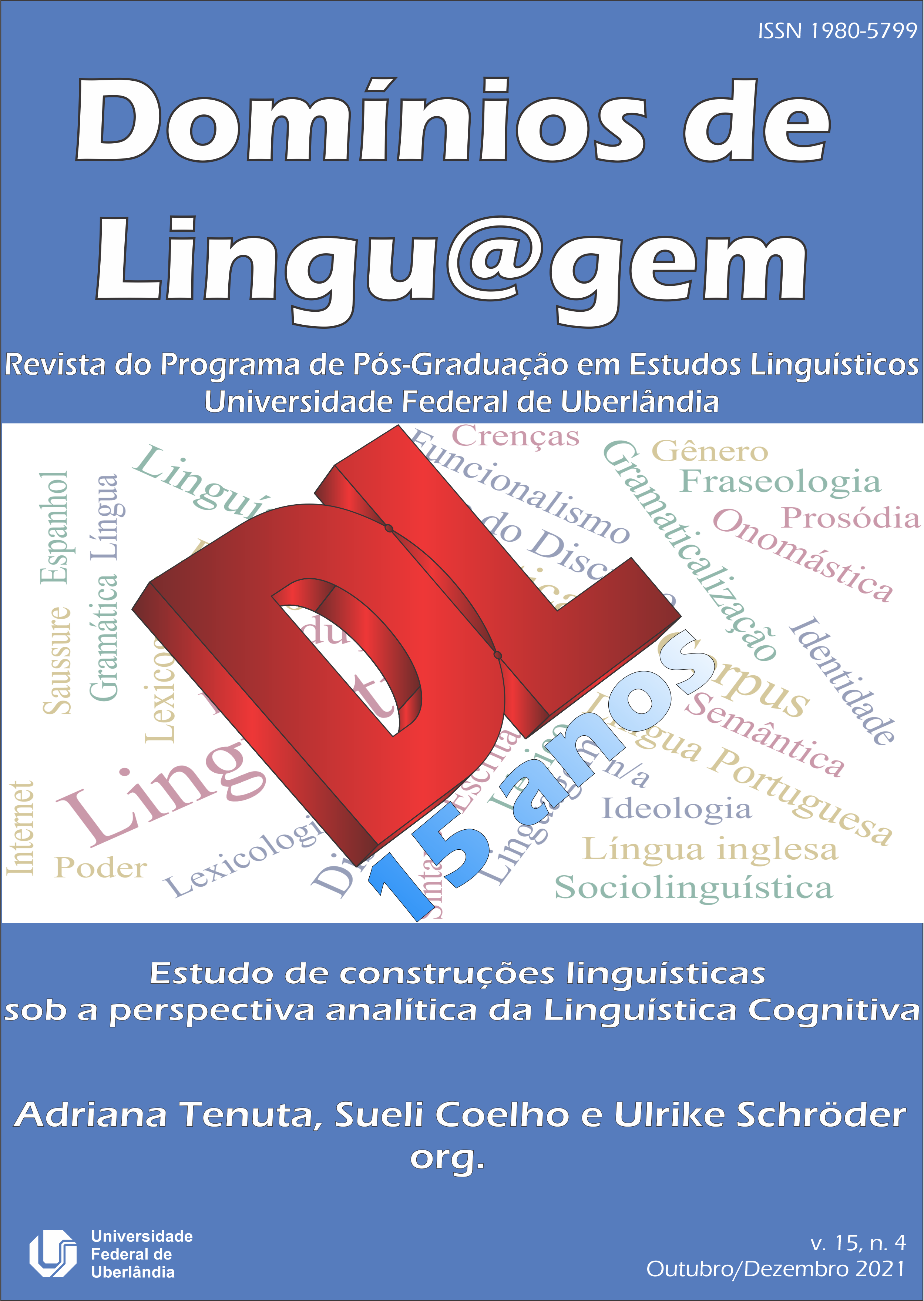The constructional change nano-steps
an intracontextual graduality in the path of the discourse marker micro-construction calma aí study
DOI:
https://doi.org/10.14393/DL48-v15n4a2021-6Keywords:
Construction, Constructional Change, Discourse Marker, Nano-steps, Intracontextual GradualityAbstract
The main objective of this paper is to present and apply the proposal for the analysis of nanosteps (ROSA, 2019), that is, gradual changes, in form or content, that occurred in a same context of construction change. To this end, the object of study selected is the refraining argumentative discourse marker micro-construction calma aí. Inserted in the scope of Cognitive-Functional Linguistics or Usage-Based Functional Linguistics, such treatment has as its fundamental theoretical bases the constructionalist approach (TRAUGOTT; TROUSDALE, 2013) and the principles of linguistic change contexts (DIEWALD, 2002, 2006; DIEWALD; SMIRNOVA, 2012). As this is part of a broader panchronic research, this work contains data collected in the Diário do Congresso Nacional, with publications from the 20th and 21st centuries. It appears that the analysis through the examination of nano-steps provides more accurate verification of processes, such as metonymization and metaphorization, which result in constructional change. In addition, it is possible to identify more precisely the characteristics of the form (syntactic, morphological and phonological) and the content (semantic, pragmatic and discursive) of the construction at each stage of change.
Downloads
Metrics
References
BOOIJ, G. Et. Morphology in Construction Grammar. In: HOFFMANN, T.; TROUSDALE, G. (ed.). The Oxford Handbook of Construction Grammar. Oxford: University Press, 2013. p. 255-273. DOI https://doi.org/10.1093/oxfordhb/9780195396683.013.0014
BYBEE, J. Language, usage and cognition. New York: Cambridge University Press, 2010. DOI https://doi.org/10.1017/CBO9780511750526
CÂMARA JR, J. M. Estrutura da língua portuguesa. Petrópolis: Vozes, 1985.
CHARAUDEAU, P. Grammaire du sens et de l’expression. Paris: Hachette Éducation, 1992.
CROFT, W. Radical construction grammar: syntactic theory in typological perspective. Oxford: Oxford University Press, 2001. DOI https://doi.org/10.1093/acprof:oso/9780198299554.001.0001
CUNHA, M. A. F. da; LACERDA, P. F. A. da C. Gramática de construções: princípios básicos e contribuições. In: OLIVEIRA, M. R. de; CEZARIO, M. M. (org.). Funcionalismo Linguístico: vertentes e diálogos. Niterói: UFF, 2017.
DIEWALD, G. A model for relevant types of contexts in grammaticalization. In: WISHER, I.; DIEWALD, G. (ed.). New reflections on grammaticalization. Amsterdam: John Benjamins, 2002. p. 103-120. DOI https://doi.org/10.1075/tsl.49.09die
DIEWALD, G. Contexts types in grammaticalization as constructions. In: Special volume 1: Constructions all over – case studies and theoretical implications. Dusseldorf, 2006. Disponível em: www.constructions-online.de:009-4-6860. Acesso em: 10 de mar. 2019.
DIEWALD, G.; SMIRNOVA, E. Paradigmatic integration: the fourth stage in an expanded grammaticalization scenario. In: DAVIDSE, K. et al. (ed.). Grammaticalization and language change – new reflections. Amsterdam/Philadelphia: John Benjamins, 2012. p. 111-131. DOI https://doi.org/10.1075/slcs.130.05die
FILLMORE, C.; KAY, P.; O’CONNOR, C. Regularity and idiomaticity in grammatical constructions: The case of let alone. Language, n. 64, p. 501–538, 1988. DOI https://doi.org/10.2307/414531
GOLDBERG, A. Constructions at Work: The Nature of Generalization in Language. Oxford: Oxford University Press, 2006.
HEINE, B. On the role of context in grammaticalization. In: WISCHER, I.; DIEWALD, G. (ed.). New Reflections on Grammaticalization [Typological Studies in Language 49], 83–101. Amsterdam: John Benjamins, 2002. DOI https://doi.org/10.1075/tsl.49.08hei
LANGACKER, R. W. Cognitive Grammar: A Basic Introduction. New York: Oxford University Press, 2008. DOI https://doi.org/10.1093/acprof:oso/9780195331967.001.0001
MARTELOTTA, M. E.; ALONSO, K. S.. Funcionalismo, cognitivismo e a dinamicidade da língua. In: SOUZA, E. R. de. (org.). Funcionalismo linguístico: novas tendências teóricas. São Paulo: Contexto, 2012. p. 87-106.
OLIVEIRA, M. R. de; ARENA, A. B. O viés funcional do pareamento simbólico função < > forma na abordagem construcional da gramática. Soletras, Rio de Janeiro, n. 37, p. 30-58, jan-jun. 2019. DOI https://doi.org/10.12957/soletras.2019.37628
ROSA, F. S. da L. A mesoconstrução marcadora discursiva refreador-argumentativa: uma análise cognitivo-funcional. 216 fls. Tese (Doutorado em Estudos de Linguagem) Instituto de Letras, Universidade Federal Fluminense, Niterói: RJ, 2019.
TOMASELLO, M. Introduction: a cognitive-functional perspective on language structure. In: TOMASELLO, M. (ed.). The new psychology of language: cognitive and functional approaches to language structure. New Jersey: LEA, 1998. p. 7-23.
TOMASELLO, M. Constructing a language: a usage-based theory of language acquisition. Cambridge, MA: Harvard University Press, 2003.
TRAUGOTT, E.-C. Grammaticalization, constructions and the incremental development of language: Suggestions from the development of degree modifiers in English. In: ECKARDT, Regine; JÄGER, G.; VEENSTRA, T. (ed.). Variation, Selection, Development: Probing the Evolutionary Model of Language Change. Berlin/New York: Mouton de Gruyter, 2008. p. 219-250.
TRAUGOTT, E.-C.; DASHER, R. Regularity in semantic change. Cambridge: Cambridge University Press, 2005.
TRAUGOTT, E.-C.; TROUSDALE, G. Constructionalization and constructional changes. Oxford: Oxford University Press, 2013. DOI https://doi.org/10.1093/acprof:oso/9780199679898.001.0001
Published
How to Cite
Issue
Section
License
Copyright (c) 2021 Flávia Saboya da Luz Rosa

This work is licensed under a Creative Commons Attribution-NonCommercial-NoDerivatives 4.0 International License.
Authors who publish in this journal agree to the following terms:
Authors retain the copyright and waiver the journal the right of first publication, with the work simultaneously licensed under the Creative Commons Attribution License (CC BY-NC-ND 4.0), allowing the sharing of work with authorship recognition and preventing its commercial use.
Authors are authorized to take additional contracts separately, for non-exclusive distribution of the version of the work published in this journal (publish in institutional repository or as a book chapter), with acknowledgment of authorship and initial publication in this journal.









